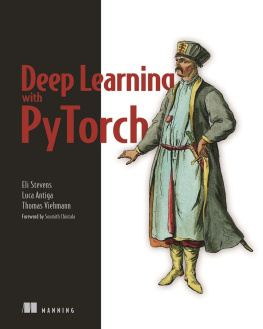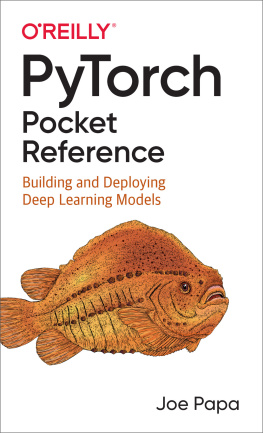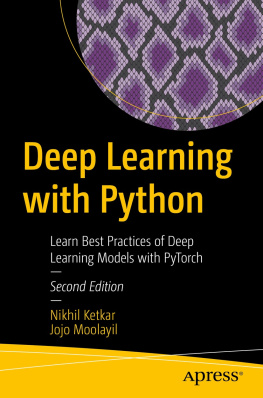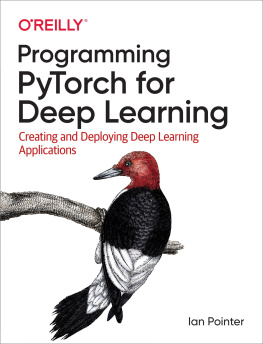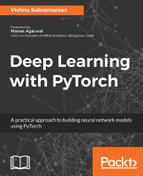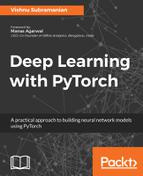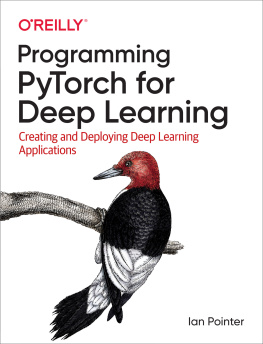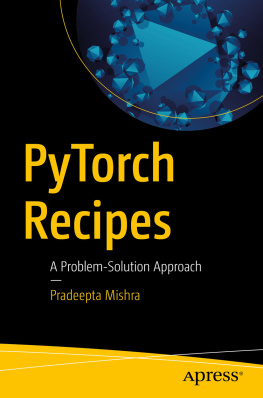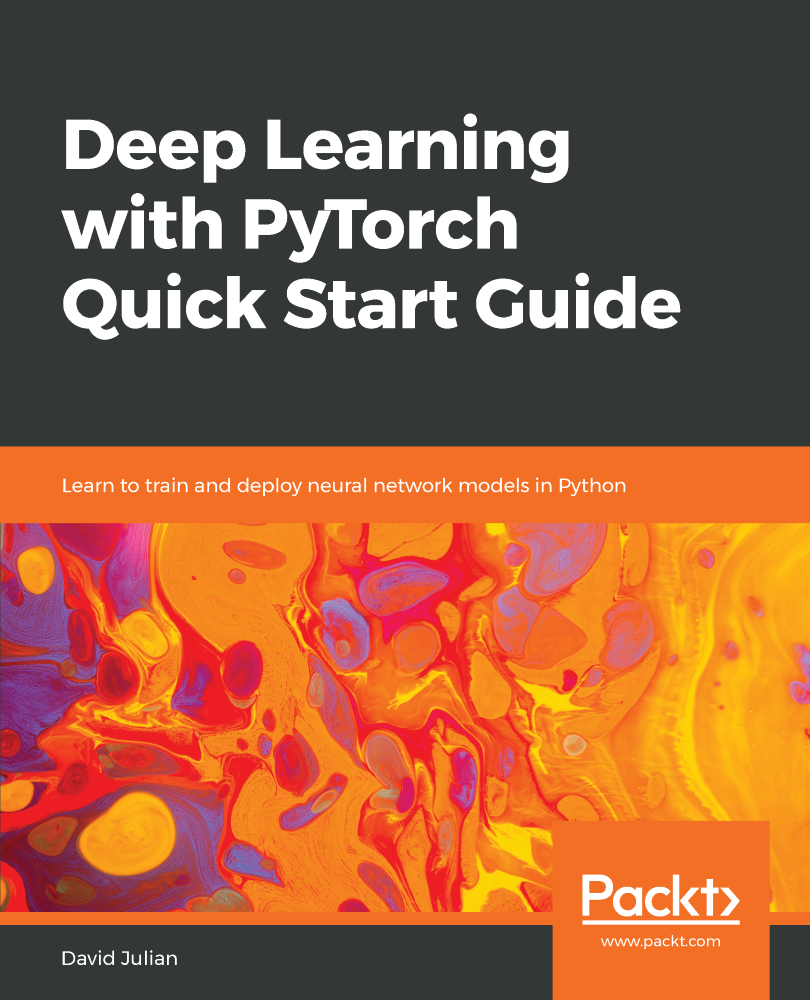
Deep Learning with PyTorch Quick Start Guide
Learn to train and deploy neural network models in Python
David Julian

BIRMINGHAM - MUMBAI
Deep Learning with PyTorch Quick Start Guide
Copyright 2018 Packt Publishing
All rights reserved. No part of this book may be reproduced, stored in a retrieval system, or transmitted in any form or by any means, without the prior written permission of the publisher, except in the case of brief quotations embedded in critical articles or reviews.
Every effort has been made in the preparation of this book to ensure the accuracy of the information presented. However, the information contained in this book is sold without warranty, either express or implied. Neither the author(s), nor Packt Publishing or its dealers and distributors, will be held liable for any damages caused or alleged to have been caused directly or indirectly by this book.
Packt Publishing has endeavored to provide trademark information about all of the companies and products mentioned in this book by the appropriate use of capitals. However, Packt Publishing cannot guarantee the accuracy of this information.
Commissioning Editor: Amey Varangaonkar
Acquisition Editor: Noyonika Das
Content Development Editor: Kirk Dsouza
Technical Editor: Sushmeeta Jena
Copy Editor: Safis Editing
Project Coordinator: Hardik Bhinde
Proofreader: Safis Editing
Indexer: Mariammal Chettiyar
Graphics: Alishon Mendonsa
Production Coordinator: Nilesh Mohite
First published: December 2018
Production reference: 1201218
Published by Packt Publishing Ltd.
Livery Place
35 Livery Street
Birmingham
B3 2PB, UK.
ISBN 978-1-78953-409-2
www.packtpub.com
mapt.io
Mapt is an online digital library that gives you full access to over 5,000 books and videos, as well as industry leading tools to help you plan your personal development and advance your career. For more information, please visit our website.
Why subscribe?
Spend less time learning and more time coding with practical eBooks and Videos from over 4,000 industry professionals
Improve your learning with Skill Plans built especially for you
Get a free eBook or video every month
Mapt is fully searchable
Copy and paste, print, and bookmark content
Packt.com
Did you know that Packt offers eBook versions of every book published, with PDF and ePub files available? You can upgrade to the eBook version at www.packt.com and as a print book customer, you are entitled to a discount on the eBook copy. Get in touch with us at customercare@packtpub.com for more details.
At www.packt.com , you can also read a collection of free technical articles, sign up for a range of free newsletters, and receive exclusive discounts and offers on Packt books and eBooks.
Contributors
About the author
David Julian is a freelance technology consultant and educator. He has worked as a consultant for government, private, and community organizations on a variety of projects, including using machine learning to detect insect outbreaks in controlled agricultural environments (Urban Ecological Systems Ltd., Bluesmart Farms), designing and implementing event management data systems (Sustainable Industry Expo, Lismore City Council), and designing multimedia interactive installations (Adelaide University). He has also written Designing Machine Learning Systems With Python for Packt Publishing and was technical reviewer for Python Machine Learning and Hands-On Data Structures and Algorithms with Python - Second Edition, published by Packt.
About the reviewer
AshishSingh Bhatia has more than 10 years' IT experience in different domains, including ERP, banking, education, and resource management. He is a learner, reader, and developer at heart. He is passionate about Python, Java, and R. He loves to explore new technologies. He has also published two books: Machine Learning with Java and R and Natural Language Processing with Java. Apart from this, he has also recorded a video tutorial on PyTorch.
Packt is searching for authors like you
If you're interested in becoming an author for Packt, please visit authors.packtpub.com and apply today. We have worked with thousands of developers and tech professionals, just like you, to help them share their insight with the global tech community. You can make a general application, apply for a specific hot topic that we are recruiting an author for, or submit your own idea.
Preface
PyTorch is surprisingly easy to learn and provides advanced features such as a supporting multiprocessor, as well as distributed and parallel computation. PyTorch has a library of pre-trained models, providing out-of-the-box solutions for image classification. PyTorch offers one of the most accessible entry points into cutting-edge deep learning. It is tightly integrated with the Python programming language, so for Python programmers, coding it seems natural and intuitive. The unique, dynamic way of treating computational graphs means that PyTorch is both efficient and flexible.
Who this book is for
This book is for anyone who wants a straightforward, practical introduction to deep learning using PyTorch. The aim is to give you an understanding of deep learning models by direct experimentation. This book is perfect for those who are familiar with Python, know some machine learning basics, and are looking for a way to productively develop their skills. The book will focus on the most important features and give practical examples. It assumes you have a working knowledge of Python and are familiar with the relevant mathematical ideas, including with linear algebra and differential calculus. The book provides enough theory to get you up and running without requiring rigorous mathematical understanding. By the end of the book, you will have a practical knowledge of deep learning systems and able to apply PyTorch models to solve the problems that you care about.
What this book covers
, Introduction to PyTorch , gets you up and running with PyTorch, demonstrates its installation on a variety of platforms, and explores key syntax elements and how to import and use data in PyTorch.
, Deep Learning Fundamentals , is a whirlwind tour of the basics of deep learning, covering the mathematics and theory of optimization, linear networks, and neural networks.
, Computational Graphs and Linear Models , demonstrates how to calculate the error gradient of a linear network and how to harness it to classify images.
, Convolutional Networks , examines the theory of convolutional networks and how to use them for image classification.
, Other NN Architectures
Next page


